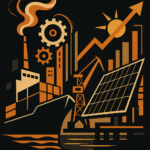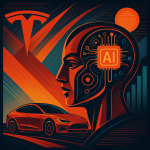Key Points
- The MIIT (Ministry of Industry and Information Technology) is initiating a major policy shift to combat “involutionary competition” in sectors like NEV (New Energy Vehicle) and solar, moving towards more controlled, sustainable industrial growth.
- China’s industrial economy showed strong resilience in H1 2025, with Industrial Value-Added up 6.4% and Equipment Manufacturing up a whopping 10.2% year-on-year.
- Key priorities for H2 2025 include boosting domestic demand, fortifying supply chains for independence and control, integrating tech and industrial innovation, and deepening digital transformation with “AI + Manufacturing” initiatives.
- MIIT plans to expand digital infrastructure, with 4.55 million 5G base stations already in place, and nurture “Specialized, Refined, Unique, and New” (专精特新) SMEs.
- A crucial focus is on modernizing governance in key sectors, including a definitive cleanup of “involutionary” competition in the NEV industry and strengthening governance in photovoltaics to force out inefficient production capacity.

China’s top industrial regulator, the Ministry of Industry and Information Technology (MIIT), has just dropped its playbook for the second half of 2025, and it’s a must-read for anyone in tech, finance, or manufacturing.
The big headline? A direct shot at the “involutionary competition” that has defined the red-hot New Energy Vehicle (NEV) sector.
This signals a major policy shift from growth-at-all-costs to a more controlled, sustainable industrial strategy.
At a national seminar in Beijing on July 28, 2025, Minister Li Lecheng (Li Lecheng 李乐成) laid out a comprehensive plan.
Let’s break down what’s happening.
First, The Scorecard: China’s Industrial Engine in H1 2025
Before diving into the future, let’s look at the numbers from the first half of the year. China’s industrial economy is showing serious resilience.
- Industrial Value-Added: Up 6.4% year-on-year.
- Manufacturing Value-Added: Up 7% year-on-year.
- Equipment Manufacturing: Up a whopping 10.2% year-on-year.
- High-Tech Manufacturing: Up a strong 9.5% year-on-year.
- Software & IT Services Revenue: Grew 11.9% year-on-year.
- Telecom Business Volume: Up 9.3% year-on-year.
The foundation is also getting stronger:
- 5G Base Stations: Reached 4.55 million.
- Computing Power: Totaled 10.43 million standard racks in use.
The takeaway? The underlying engine is humming, especially in high-tech and manufacturing, setting the stage for the next phase of strategic initiatives.

Resume Captain
Your AI Career Toolkit:
- AI Resume Optimization
- Custom Cover Letters
- LinkedIn Profile Boost
- Interview Question Prep
- Salary Negotiation Agent

The 8 Key Priorities for H2 2025: What You Need to Know
- 5G Base Stations: Over 4.55 million installations
- Computing Power: 10.43 million standard racks in use
MIIT outlined eight key focus areas. Think of this as a strategic roadmap for where capital, talent, and policy support will flow.
1. Pumping Up Domestic Demand
The plan isn’t just about producing more; it’s about getting people to buy more, especially high-tech goods.
- Launching the “Ten Key Industry Stable Growth Actions” (Shida Zhongdian Hangye Wen Zengzhang Xingdong 十大重点行业稳增长行动).
- Boosting consumption of next-gen gadgets like AI terminals, ultra-high-definition video, smart wearables, and drones.
- Expanding financial support for “new industrialization” through a “Technology, Industry, and Finance Integration” initiative.
- Getting serious about clearing outstanding corporate debts to improve business health.
2. Fortifying Key Industrial Supply Chains
This is all about resilience and self-sufficiency. Beijing wants to control its own destiny.
- Strengthening weak links and building on strong suits to make key industrial chains independent and controllable.
- Doubling down on securing strategic mineral resources.
- Optimizing the global layout for key industrial chains through industrial transfer events.
3. Melding Tech Innovation with Industrial Innovation
It’s time to turn cutting-edge R&D into real-world products and industries.
- Rolling out major national science and tech projects.
- Improving development policies for futuristic sectors like humanoid robots, the Internet of Things (IoT), and high-end instrumentation.
- Boosting service-oriented manufacturing and industrial design to move up the value chain.
- Advancing the Harbin-Changchun-Shenyang-Dalian industrial technology innovation corridor.
4. Deepening Digital Transformation & “AI + Manufacturing”
This is where the digital and physical worlds collide. The focus is on embedding AI and data into the core of China’s manufacturing might.
- Formulating new rules for using data to power industrial digital transformation.
- Improving policies for critical basic software and industrial software.
- Building a national artificial intelligence open-source community to foster collaboration.
- Launching the “AI + Manufacturing” initiative to drive core tech breakthroughs.
- Cultivating a new generation of “industrial intelligent bodies” (think AI-powered factories).
5. Driving Green Development and Efficiency
China is getting serious about sustainability, not just for the planet but for long-term industrial health.
- Establishing a carbon footprint accounting standard system for industrial products.
- Building “waste-free parks” and “waste-free enterprises.”
- Toughening up management on the recycling of power batteries for both NEVs and electric bicycles.
- Upgrading green factories and promoting green, low-carbon supply chains.
6. Upgrading the Digital Backbone (Info & Comms)
The digital economy runs on robust infrastructure, and MIIT is planning a major upgrade.
- Pushing for wider adoption and better quality of 5G and gigabit optical networks.
- Continuing the “Signal Enhancement” special action to fix connectivity dead zones.
- Boosting the supply and efficiency of intelligent computing resources (aka, the brains for AI).
- Optimizing market access for satellite communication services.
- Cracking down on telecom and network fraud.
7. Cultivating “Little Giant” Enterprises
China isn’t just betting on its tech giants. It’s building an army of highly specialized, world-class small and medium-sized enterprises (SMEs).
- Issuing new policies to promote the growth of “Specialized, Refined, Unique, and New” (Zhuānjīngtèxīn 专精特新) SMEs.
- This is huge. These companies are the hidden champions of the supply chain, and Beijing wants more of them.
- Exploring a “review-free, direct benefit” mechanism to get preferential policies to high-quality companies faster.
8. The Big Cleanup: Modernizing Governance in Key Sectors
This is arguably the most important point. MIIT is stepping in to clean up industries suffering from hyper-competition.
- Consolidating the results of the “involutionary” competition cleanup in the NEV industry. “Involution” (内卷, nèijuǎn) refers to a zero-sum game of intense internal competition that drives down profits and stifles innovation. This signals an end to the brutal, unfettered price wars.
- Strengthening governance in key industries like photovoltaics (solar). The goal is to use higher standards to force out backward, inefficient production capacity.
- This is a clear message: The era of chaotic, cut-throat competition is ending. The era of structured, high-quality development is beginning.
What This Means for You
China’s industrial policy is clearly shifting gears.
The focus is moving from scale at any cost to strategic, high-quality, and controlled growth.
For investors and founders, this roadmap highlights where the government’s support—and money—is heading: AI, humanoid robots, IoT, “专精特新” SMEs, and green tech.
For those in the EV and solar industries, brace for consolidation. Weaker players may be forced out as Beijing prioritizes profitability and orderly competition over market share chaos.
This new MIIT China tech policy is a blueprint for building a more resilient, self-sufficient, and technologically advanced industrial base, ready to compete on a global scale.




![Small Nuclear Reactors & Data Centers: Why China is Leading the Charge [FreshFromChina]](https://freshfromchina.com/wp-content/uploads/2025/05/Small-Nuclear-Reactors-Data-Centers-Why-China-is-Leading-the-Charge___FreshFromChina-150x150.png)
![Microsoft Market Cap Explodes by ¥1.6 Trillion RMB Overnight, While Apple Stock Takes a Hit Post-Earnings [FreshFromChina]](https://freshfromchina.com/wp-content/uploads/2025/05/Microsoft_Market_Cap_Explodes_by_1.6_Trillion_RMB_Overnight__While_Apple_Stock_Takes_a_Hit_Post-Earnings____FreshFromChina-150x150.png)
